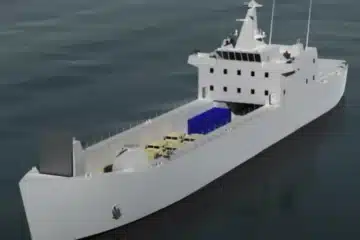USMC press release
More than 5,500 personnel will participate in Resolute Dragon 22 in Hokkaido, Japan and in KAMANDAG 6 across Luzon, Batanes, and Palawan in the Philippines.
The 3d Marine Division headquarters, based in Okinawa, will exercise command and control for U.S. forces involved in both exercises and provide liaison officers to the U.S. Indo-Pacific Command to rehearse concepts associated with functioning as a joint task force.
“Resolute Dragon and KAMANDAG are important opportunities to bolster the defensive capabilities of our alliances with Japan and the Philippines through realistic combined training,” said Maj. Gen. Jay Bargeron, 3d Marine Division Commanding General. “These exercises will allow our forces to strengthen interoperability and readiness to ensure we are prepared to rapidly respond to crisis throughout the Indo-Pacific.”
More than 2,500 members of the Armed Forces of the Philippines and the U.S. Marine Corps are joining forces for the annual bilateral exercise KAMANDAG 6, which takes place Oct. 3-14.
Meanwhile, 1,400 Japan Ground Self-Defense Force (JGSDF) members from the 2nd Division, Northern Army and 1,600 U.S. Marines from across III Marine Expeditionary Force will conduct Resolute Dragon 22, the second annual iteration of the exercise, Oct. 1-14.
“Today, as the security environment surrounding Japan becomes more turbulent, there is a need to further strengthen the deterrence and response capabilities of the Japan-U.S. Alliance,” said Gen. Yuichi Togashi, the JGSDF 2nd Division Commanding General. “For this reason, we recognize that Resolute Dragon, the largest field training exercise with the U.S. Marine Corps in Japan, is extremely important in terms of further strengthening the cooperation between the Japan Ground Self-Defense Force and the U.S. Marine Corps. It is my hope that through this training, the Japanese and U.S. Forces will deepen mutual understanding, improve their tactical skills and joint response capabilities to the operational level, and, in turn, further strengthen the Japan-U.S. Alliance.”
During KAMANDAG, 530 Philippine Marines and 1,900 U.S. Marines will train closely together, along with about 100 members of the Philippine Navy and Air Force. The force will focus on increasing combined capabilities for amphibious operations, special operations, maritime security, coastal defense, combined arms, and humanitarian assistance and disaster relief.
“The Philippine Marine Corps looks forward to this year’s KAMANDAG exercise with our foreign military allies who are advanced in terms of amphibious operations, special operations, HADR operations, and territorial defense capabilities,” said the Philippine Marine Corps Commandant, Maj. Gen. Charlton Sean M. Gaerlan. “Through this exercise, we are able to learn from their techniques, tactics, and procedures to develop our interoperability strategy in the Philippine Marine Corps, especially as we operationalize our Marine Corps Operating Concept for Archipelagic Coastal Defense.”
This iteration of KAMANDAG 6 will also feature about 30 members of the JGSDF Amphibious Rapid Deployment Brigade and approximately 100 Republic of Korea Marines within select events of the exercise.
KAMANDAG 6 will include numerous combined interoperability events to include a combined arms live-fire exercise in central Luzon featuring aircraft and High Mobility Artillery Rocket Systems (HIMARS) as well as amphibious operations along the eastern and northern coasts.
Resolute Dragon 22 will also include a combined arms live-fire event featuring the JGSDF Multiple Launch Rocket System and U.S. Marine Corps HIMARS among other weapons systems. Resolute Dragon focuses on enhancing bilateral command and control, multi-domain maneuver, and fires and effects in a geographically distributed environment.
KAMANDAG 6 and Resolute Dragon 22 are important components to maintaining the readiness and defensive capabilities of the U.S.-Philippines alliance and the U.S.-Japan alliance.
“KAMANDAG” stands for “Kaagapay Ng Mga Mandirigma Ng Dagat” which is Tagalog for “Cooperation of the Warriors of the Sea.” The purpose of this exercise is to strengthen cooperation, interoperability, and relationships among participating forces.
Exercises like KAMANDAG and Resolute Dragon strengthen international partnerships, mutual security, and the ability to rapidly respond to crises throughout the Indo-Pacific.
The U.S. Marine Corps’ participation in KAMANDAG 6 and Resolute Dragon 22 will be led by the 3d Marine Division, headquartered on Okinawa, Japan, providing overall command and control for U.S. forces in both exercises.
U.S. Marine Corps units participating in KAMANDAG 6 in the Philippines include the 3d Marine Division; 31st Marine Expeditionary Unit; elements of the 11th Marine Expeditionary Unit; elements of 4th Marine Regiment; Combat Logistics Regiment 3; and 1st Battalion, 2d Marines. Additionally, Task Force 76/3 will conduct operations for the first time as an integrated staff during the exercise. TF 76/3 was recently formed as a result of merging the staffs of U.S. Navy’s Task Force 76, Seventh Fleet, and 3d Marine Expeditionary Brigade, III Marine Expeditionary Force. U.S. Marine Corps aircraft involved in KAMANDAG 6 will be primarily sourced from the 31st MEU and include the F-35B Lightning II, MV-22B Osprey, CH-53E Super Stallion, AH-1Z Viper, UH-1Y Venom, and KC-130J Super Hercules.
U.S. Marine Corps units participating in Resolute Dragon 22 in Hokkaido include the 12th Marine Regiment; 3d Battalion, 12th Marines; 3d Battalion, 3d Marines; 3d Reconnaissance Battalion, and 3d Transportation Battalion; and multiple squadrons from 1st Marine Aircraft Wing bringing MV-22B Ospreys, CH-53E Super Stallions, AH-1Z Vipers, UH-1Y Venoms, KC-130J Super Hercules, and F/A-18 Hornets.






